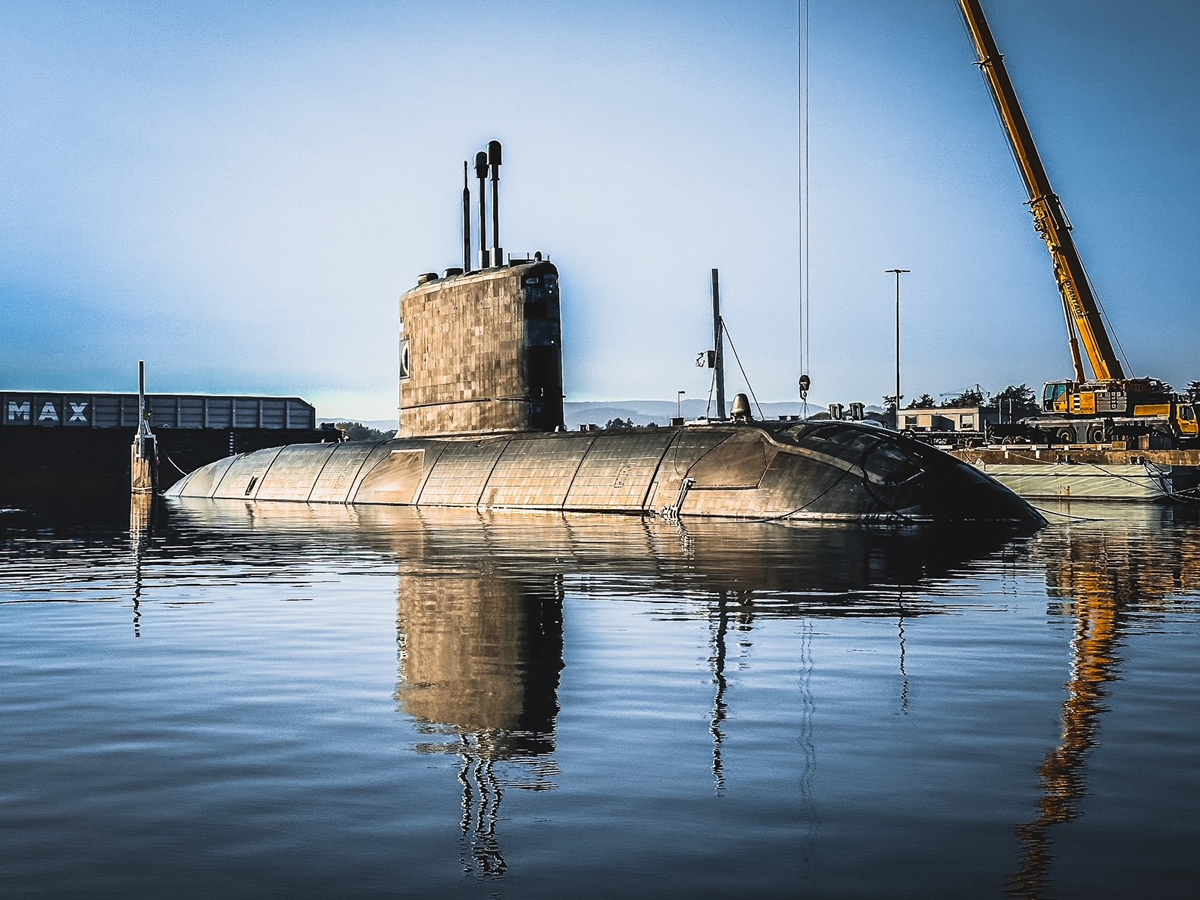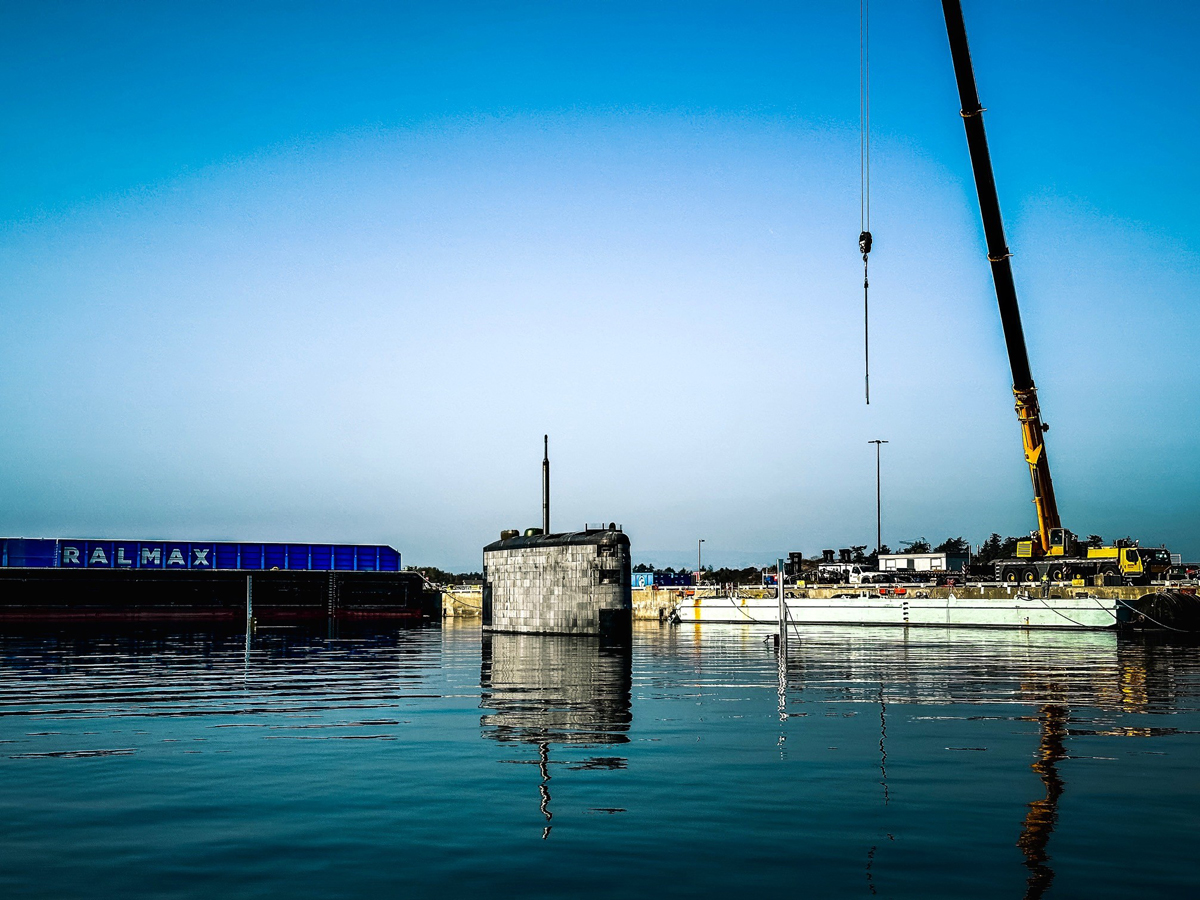HMCS Corner Brook dives towards returning to the fleet
By Lookout Production on Dec 11, 2022 with Comments 0

As part of the Camber Dive, HMCS Corner Brook confirms the functionality of the systems in a dived state and returns alongside at Ogden Point (above).
Kateryna Bandura,
Lookout Editor
—
HMCS Corner Brook, one of the Royal Canadian Navy (RCN) submarines, completed the well-anticipated Camber Dive in October.
The trial marks a milestone in the next stage of its Tiered Readiness Program.
“The dive tests are a major milestone as they mark the completion of all systems’ refit to dive the submarine successfully,” said James Charsley, Project Manager – Submarines from Babcock Canada (Babcock).
The trials were held Oct. 18-20 by HMCS Corner Brook’s crew and Babcock, the main contractor for major RCN submarine refits and upgrades.
It began with a ‘cold’ move of the Corner Brook to Ogden Point for dived trim and incline trials, followed by the Camber Dive to test its watertight integrity, sonar, and other key systems.
“The Camber Dive portion gives the crew the opportunity, in a controlled environment, to do initial testing on an array of systems that can only be tested once the submarine is under water,” said Chief Petty Officer Second Class (CPO2) Nelson Harvey, National Submarine Search and Rescue (SUBSAR) Coordinator at Canadian Submarine Force (CANSUBFOR) HQ.
Some of these systems are but are not limited to, the underwater telephones, escape systems, sonars, submerged signal ejectors, and high-pressure air systems required to surface the submarine.
The tests at Ogden Point are the first step in getting the crew and the submarine ready for seagoing operations following the submarine’s extensive refit and upgrades, which began in 2011, CPO2 Harvey said.
He said the mountain of work to get the submarine to this point is quite extensive.
“Before the Camber Dive, the crew and the submarine undergo a lot of training, culminating in simulated sea time alongside known as a ‘Fast Cruise’. This training runs the crew through exercises such as floods, fire, electrical failures, and casualty extraction,” CPO2 Harvey said.
He said Ogden Point is deep enough for the static dive trials and has little to no current to interfere with trim and incline calculations.
The Trim and Incline trials are designed to get exact measurements of how much water needs to be in specific tanks for the submarine to float level on all three axes. The results of these tests help better understand the submarine’s stability.
While the submarine is under water, trials are conducted to confirm the functionality of the systems in a dived state. The teams can certify the various submarine systems for operations through empirical data before proceeding to sea.
The results captured during the October trials are evaluated by various experts within the Department of National Defense in Ottawa and on the Coast to determine if anything requires further investigation.
“Some results are obvious such as the release of the indicator buoys; others may require further analysis,” Charsley said. “The math around the Trim and Incline, for example, is a multi-week process with various levels of checks and independent reviews to ensure the numbers are interpreted correctly.”
Babcock works with other military contractors to upgrade communications and sonar systems, as well as any mechanical upgrades deemed necessary for the modernization of the RCN’s submarine force.
“There are over 2,500 tests and trials conducted throughout the refit as the submarine gets ready for final sea trials. With the initial dives complete, the remaining tests can now be finalized,” Charsley said.
“Once the trials data has been assessed and the corrections have been made, Corner Brook can be cleared to go for at-sea trials, which will involve navigation trials, and testing structural integrity and escape equipment at depth. That phase will take a few months at sea,” CPO2 Harvey said. “After that, Corner Brook’s crew will undergo crew and platform readiness training under the guidance of Sea Training, as well as a full weapons certification.”
Once HMCS Corner Brook is fully operational, the crew will be back at sea, training future submariners and honing their skills for force employment as directed by the Canadian Joint Operations Command.
Filed Under: Top Stories
About the Author:






